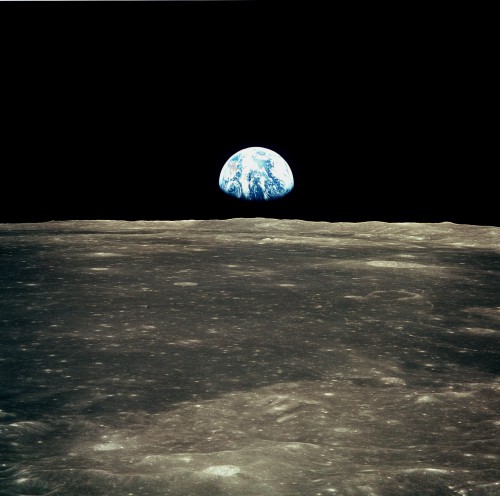
The Home Planet creeps slowly above the lunar horizon, as viewed from Apollo 11. Only a handful of men have seen this view in more than two million years of human history. Photo Credit: NASA
When Apollo 11 and its three-man crew—Neil Armstrong, Mike Collins and Buzz Aldrin—rose into space 50 years ago, this month, they embarked on the grandest adventure ever undertaken in human history: the first piloted voyage to the surface of the Moon. Yet, strangely, even after surviving a tumultuous launch atop the mammoth Saturn V rocket, performing the translunar injection burn, and entering the mysterious region between Earth and the Moon, known as “cislunar space”, the main part of the mission had yet to begin. Their mission would really start after Lunar Orbit Insertion (LOI) on 19 July, and the series of increasingly bold and epochal events thereafter.
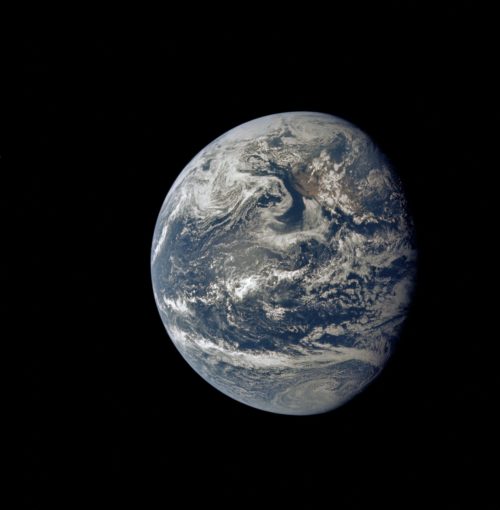
Spectacular view of Earth, captured during Apollo 11’s translunar coast. The spacecraft was approximately 11,500 miles (18,520 km) from the Home Planet, heading for the Moon, when this photograph was acquired. Photo Credit: NASA
The resultant quietness of those three days was not helped, in the opinion of mission controllers, by a lack of conversation from the astronauts. “It’s all dead air and static,” a Houston official complained at one stage of the cislunar coast. The lengthy spells of silence were, however, punctuated by televised shows in which the crew guided a worldwide audience around their ship, revealing the dismantling of the probe and drogue mechanism, a shimmy through the tunnel and an “upside-down” glimpse of Lunar Module (LM) Eagle’s tiny cabin, with Aldrin, toting dark aviator sunglasses, hard at work.
Several of these shows were made by Collins, who enjoyed rotating the camera 180 degrees to turn his Earthbound audience on its head and back again; but, in reality, none of them had ever had much chance to practice with the camera on the ground and its late delivery to Cape Kennedy had not helped matters. “We simply didn’t have time to fool around with it,” he wrote in his autobiography, Carrying the Fire. “Neil and Buzz didn’t even know how to turn it on or focus it, and my knowledge of it was pretty sketchy.” With this in mind, they were advised by a helpful instructor that an audience of perhaps a billion or more people would be watching and that screwing up one of their shows was not an option.
The quiet time was interspersed with inevitable chores, mainly performed by Collins: purging fuel cells, charging batteries, dumping waste water and urine, preparing food, dechlorinating the ship’s water supply, and, notably, performing a midcourse correction burn to refine their path toward the Moon. Twenty-six hours into the mission, and almost 110,000 miles (175,000 km) from home, the Service Propulsion System (SPS) engine of the Command and Service Module (CSM) Columbia roared silently into the void for three seconds in what flight controllers lauded as an “absolutely nominal” firing.
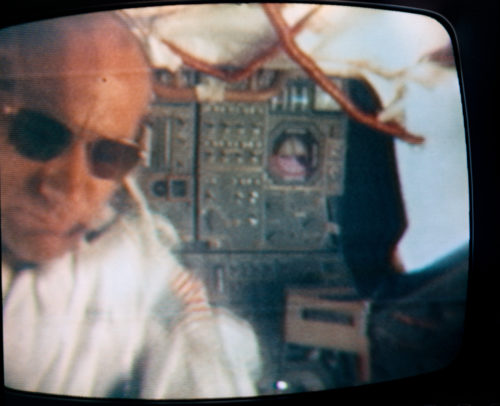
Clad in aviator sunglasses, Buzz Aldrin offers a televised tour of the Lunar Module (LM) Eagle, early in the Apollo 11 mission. Photo Credit: NASA
Collins related that, for those few seconds, he was in active control. Several months earlier, in December 1968, his young son had asked who was “driving” Apollo 8 to the Moon: was it Mr. Borman, the ship’s commander? No, Collins replied, it was Sir Isaac Newton—or, at least, the influences of Sun, Earth and Moon, which affected the spacecraft’s path just as the great English scientist’s law of universal gravitation had helped predict three centuries before.
The accuracy of the midcourse burn was so good that two subsequent SPS firings were deemed unnecessary, and late on 18 July, precisely on schedule, some 43,500 miles (70,000 km) from their target, Columbia and Eagle slipped into the Moon’s sphere of influence. For the past three days, still under the tug of Earth’s gravity, their speed had rapidly decreased from 24,200 mph (39,000 km/h) immediately after Trans-Lunar Injection (TLI) to just over 2,000 mph (3,200 km/h); now, as the Moon’s gravitational pull became dominant, they began to “fall” toward it, gradually speeding up to 5,600 mph (9,000 km/h). Earlier in the evening, Collins had again removed the probe and drogue from Columbia’s docking mechanism and reopened the tunnel to allow Armstrong and Aldrin to enter Eagle and begin checking out its systems.
Both men considered the “down-up-up-down” trip into the lunar module—as they moved from the “floor” to the “ceiling” of Columbia, then found themselves diving headfirst toward Eagle’s “floor”—as one of the most unusual sensations of their mission, although Aldrin described the transition as “perfectly natural,” akin to the motions of a swimmer. For two and a half hours, they verified that the lander was ready to support an undocking and a landing attempt on the afternoon of 20 July and viewers in the United States, western Europe, Japan and most of South America were treated to the sight of Aldrin performing an equipment inventory inside the tiny cabin.
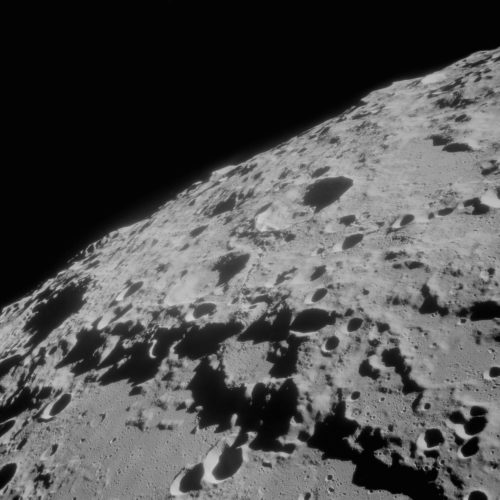
The forbidding face of the lunar farside, as seen from Apollo 11. Photo Credit: NASA
That evening offered some more quiet time before the historic events to come. Aldrin recalled asking Armstrong if he had decided what he was going to say when he stepped onto the lunar surface, to which the commander, between sips of fruit juice, replied that no, he was still thinking it over.
The sheer grandeur of the Moon itself was something totally different from the ever-present pale lamp in the sky that they had watched nightly as they grew from infancy. “The Moon I have known all my life,” Collins wrote, “has gone away somewhere, to be replaced by the most awesome sphere I have ever seen. To begin with, it is huge, completely filling our window.” It also appeared more menacing than the two-dimensional circle in Earth’s skies; he perceived it to be an intensely unwelcoming and forbidding place, “formidable” and “utterly silent” as it hung “ominously” in the void.
Back on Earth, journalists had frequently posed an inevitable question before the flight: Was Collins jealous that Armstrong and Aldrin were about to take the first steps on the Moon, while he remained in orbit? Collins had responded that in all honesty he was more than happy and content to be flying 99.9 percent of the journey. He would, it is true, be mad to suppose that he had the best seat on the mission, but he had already decided that this would be his final space flight; the strain on his wife and children, the constant grind of training, and the lengthy spells away from home were too much for them.
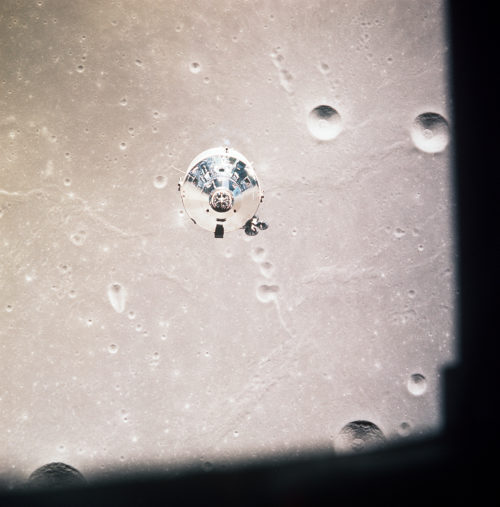
“You cats take it easy,” yelled Mike Collins from the Command and Service Module (CSM) Columbia, as seen in this view from Eagle’s windows. Photo Credit: NASA
Shortly before Apollo 11 was launched, during a cross-country T-38 flight with Deke Slayton, the man who picked crews had offered Collins the chance to serve as backup commander of Apollo 14 and most likely command Apollo 17 to the Moon. This would give Collins the chance to walk the lunar surface himself. Collins had declined. Now, as he neared the Moon on this midsummer’s evening in 1969 and looked down onto the threatening barrenness of its terrain, then recalled Earth with its waterfalls and valleys and enchanting iridescence of life, he knew he had made the right choice.
Getting into orbit around the Moon on the afternoon of 19 July was a triumph of celestial mechanics and human ability in itself. The Lunar Orbit Insertion (LOI) maneuver actually comprised two firings of the SPS engine. The first, lasting five minutes and 57 seconds, reduced their speed from 5,600 mph (9,000 km/h) to 3,700 mph (5,970 km/h) and “dropped” them into an elliptical orbit of 168 x 60 miles (270 x 97 km) with the high point on the nearside; and the second, lasting only 17 seconds, came about four hours later and almost circularized their path at roughly 65 x 54 miles (105 x 87 km). To this day, it remains remarkable that they could be guided so precisely across such an immense distance and achieve such a perfect orbit around the Moon. “Those big computers in the basement in Houston,” wrote Collins, “didn’t even whimper but belched out super-accurate predictions.” When one considers that the computing power of one of today’s mobile cellphones would dwarf the entire computing power that guided Columbia and Eagle to the Moon, the act of inserting Apollo 11 into lunar orbit was truly a stupendous achievement.
During the four-hour interval between the two burns, dubbed “LOI-1” and “LOI-2”, the opportunity arose to closely examine the surface of the strange world upon which Armstrong and Aldrin would shortly take humanity’s first steps. Initially, the television camera panned across the terrain and the crew were silent, until Mission Control requested that they describe some of what they were seeing. A group of astronomers from Bochum in West Germany had asked that they take a look at Aristarchus—a prominent, extremely bright impact crater—which had exhibited unusual luminescence over the preceding weeks.
“Hey, Houston,” radioed Armstrong, after finding the crater, “I’m looking north up toward Aristarchus now, and there’s an area that is considerably more illuminated than the surrounding area.”
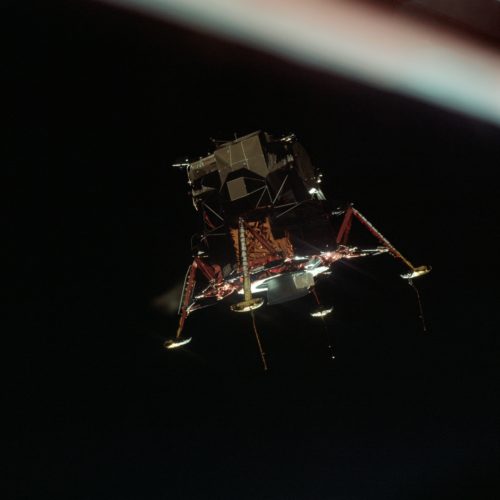
Lunar Module (LM) Eagle, with the Lunar Contact probes on three of its extended landing legs, performs a pirouette shortly after undocking. Photo Credit: NASA
Other regions and landmarks were enthusiastically identified by the crew by their nicknames—the small hills of Boot Hill and Duke Island, the snake-like rilles of Diamondback and Sidewinder and the twin peaks of “Mount Marilyn”; the latter unofficially bestowed by Apollo 8 astronaut Jim Lovell in honor of his wife—although, of course, the vast plain of Mare Tranquilitatis (the Sea of Tranquility) was of principal interest. “The Sea of Tranquillity,” wrote Collins, “is just past dawn and the Sun’s rays are intersecting its surface at a mere one-degree angle. Under these lighting conditions, craters cast extremely long shadows, and to me the entire region looks distinctly forbidding.” In Collins’ mind, it looked far too rugged to set a baby’s buggy down, let alone a lunar module.
By the early evening of 19 July, following the LOI-2 burn, which Collins had timed to the split second using a stopwatch, everything was ready for the final checkout of Eagle in advance of undocking and the Powered Descent. Luckily, since Aldrin had successfully lobbied to do much of the checkout a day early, the task took barely 30 minutes, and by 8:30 p.m. EDT all was in place as the three astronauts bedded down for a night of surprisingly fitful sleep in Columbia.
Next morning, a very groggy Mike Collins responded to Mission Control’s wake-up call and, after breakfast and a round-up of the morning news, all three men plunged into their respective checklists. Among the most important tasks were donning their space suits and, in the case of Armstrong and Aldrin, getting into the liquid-cooled underwear which would help to maintain a comfortable body temperature during their time on the lunar surface. Collins shoved the remainder of their gear— “an armload of equipment”—through the tunnel to them, then disconnected umbilicals, reinstalled the docking probe and drogue and sealed the hatch. “I am on the radio constantly now,” he wrote, “running through an elaborate series of joint checks with Eagle. In one of them, I use my control system to hold both vehicles steady while they calibrate some of their guidance equipment.” Inside the lander, anchored to the floor by bungee-like cords, Armstrong and Aldrin also had their hands full: punching entries into the computer keypad, aligning their S-band antenna with the Earth-based tracking network, checking and cross-checking VHF communications with Collins, and deploying Eagle’s landing gear.
At length, it was time to bid farewell. “You cats take it easy on the lunar surface,” Collins called cheerily. “If I hear you huffing and puffing, I’m going to start bitching at you.” A few minutes later, at 1:44 p.m. EDT on 20 July, he flipped a switch to cast Eagle loose. Yet this momentous beginning of Eagle’s descent occurred unseen by Earth, for both craft were behind the Moon at the time. Before losing radio contact, Capcom Charlie Duke gave them the good news that they had a “Go” for undocking. His infectious North Carolina drawl and endearing personality would certainly help to lift some of the tension in the hours ahead.
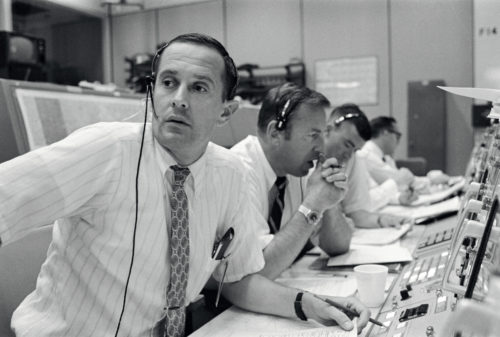
Capcom Charlie Duke (left) and Apollo 11 backup commander Jim Lovell (center) and Apollo 11 backup Lunar Module Pilot (LMP) Fred Haise are pictured at their consoles in the Mission Operations Control Room (MOCR) during the landing phase. Photo Credit: NASA
The Mission Operations Control Room (MOCR) at the Manned Spacecraft Center (MSC) in Houston, Texas, was packed with virtually everybody who mattered in the space program—Wernher von Braun, Tom Paine, George Mueller, Sam Phillips, Chris Kraft, George Low, Deke Slayton and many astronauts, all waiting for more than a decade of hard work to pay off. In addition, an estimated third of the world’s population was either watching or listening on television or radio.
Still out of direct radio contact with the ground, Collins watched, his nose pressed against one of Columbia’s windows, as Eagle drifted serenely into the inky darkness. Armstrong executed a little pirouette, fully rotating the lander to enable Collins to verify that the landing gear was in good condition. This had required Collins to take a trip to the Grumman assembly plant in Bethpage, N.Y., to familiarise himself with the lunar module, its fully extended landing legs and the long sensor prongs affixed to three of its four footpads. (One leg—the one holding the ladder—was originally to have had a sensor, too, but according to biographer James Hansen in First Man, Armstrong requested its removal, lest he or Aldrin trip over it during their climb down to the surface.)
There were other worries. One side of the descent stage held the Modular Equipment Storage Assembly (MESA), a carrier brimming with a television camera, rock boxes, and geology tools, which Armstrong would use on the lunar surface. Was it still firmly secured in place or had it accidentally swung open during the separation process? Collins assured him that all was well, Armstrong requested its removal, lest he or Aldrin trip over it during their climb down to the surface.) There were other worries. One side of the descent stage held the Modular Equipment Storage Assembly (MESA), a carrier brimming with a television camera, rock boxes, and geology tools, which Armstrong would use on the lunar surface. Was it still firmly secured in place or had it accidentally swung open during the separation process? Collins assured him that all was well.
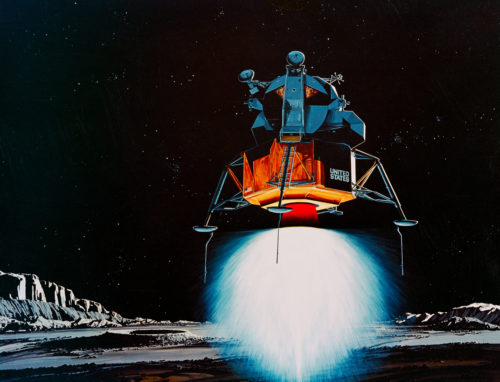
Artist’s concept of Eagle’s final descent to the lunar surface. Image Credit: NASA
With such assurances ringing in their ears, all three men could afford a brief moment of light-hearted banter, with Collins telling Eagle’s crew that they had a pretty fine-looking machine, despite being upside down, to which Armstrong retorted that, from his perspective, someone was upside down.
At 2:11 p.m. EDT, Collins fired his thrusters for a nine-second separation burn, “to give Eagle some breathing room”. And at 3:08 p.m. the first of two firings of the lander’s descent engine got underway. Known as Descent Orbit Insertion (DOI), this lasted 30 seconds and reduced the lowest point (or “perilune”) of Eagle’s orbit to a height of 9.4 miles (15.2 km), at a position convenient for initiating powered descent. The laws of celestial mechanics now became increasingly evident to Collins: In a lower orbit, Eagle was moving faster and was actually ahead of Columbia by about one minute.
As they descended toward perilune, it was necessary for Armstrong and Aldrin to cross-check their instruments, specifically the Primary Navigation, Guidance and Control System (PNGS) and Abort Guidance System (AGS). The former processed data from an inertial platform of gyroscopes and guided the lunar module along a predetermined flight path to its landing site, whilst the latter offered the ability to perform an abort if necessary. “We couldn’t land on AGS,” Armstrong told James Hansen in First Man, “unless we got right down close to the surface, because you couldn’t navigate the trajectory with it.” However, both systems had to be operating throughout the descent phase—if an emergency arose, Armstrong might need to switch instantaneously from PNGS to AGS—and it was imperative that the two systems had the same data. “If tiny errors were allowed to compound,” Hansen wrote, “gross errors in computing the LM’s course and location could result.”
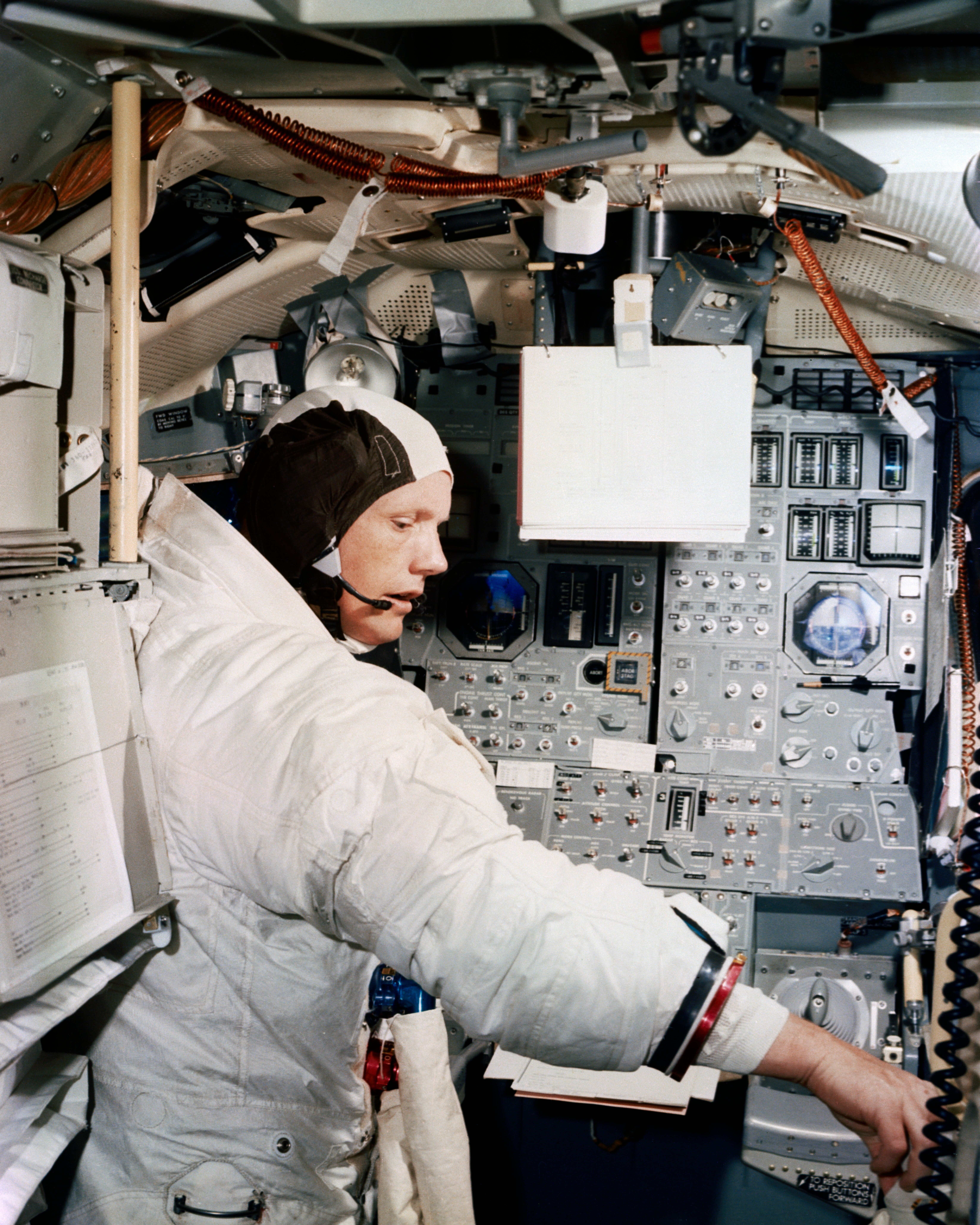
This view of Armstrong in the lunar module simulator during training illustrates the smallness of Eagle’s cabin. Photo Credit: NASA
The higher altitude of Columbia meant that Collins was first to regain contact with Houston as the two craft emerged from behind the Moon. The acquisition of signal was what the MOCR had been waiting for. When queried by Capcom Charlie Duke over the progress of the DOI burn, Collins responded simply that it had gone “just swimmingly…beautiful”.
Ninety seconds later, at 3:49 p.m., Aldrin confirmed that the DOI had gone well. Eagle’s radar was activated, verifying a perilune of 9.4 miles (15.2 km), and Duke issued a firm “Go” to begin Powered Descent. Brief, but persistent communication dropouts forced Collins to relay this to Armstrong and Aldrin and the lander’s descent engine ignited for the second time at 4:05 pm. By the time it shut down, in barely 12 minutes’ time, they would be on the Moon. Although Collins could certainly speak to them, he could no longer see them; despite having tied a small black patch over his left eye and squinting through Columbia’s sextant, the bug-like lander steadily diminished in size until it looked “like any one of a thousand tiny craters—except that it is moving.”
Eventually, it was gone.
The best thing Collins—and an anxious world—could do now was keep quiet and wait.
The third part of this article will appear next weekend.
FOLLOW AmericaSpace on Facebook and Twitter!
Missions » Apollo »



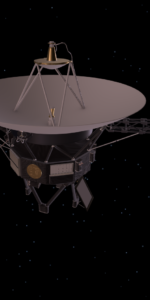
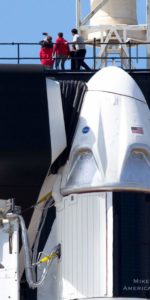
Great writing. Thank you.